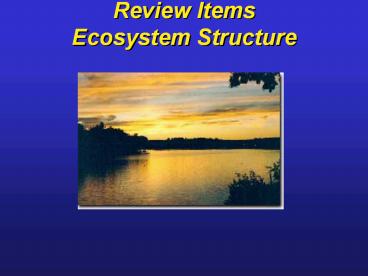Review Items Ecosystem Structure - PowerPoint PPT Presentation
Title:
Review Items Ecosystem Structure
Description:
In every transformation, some energy is converted to heat ... Diamondback rattlesnake. Diamondback rattlesnake. Darkling. beetle. Darkling. beetle. Bacteria ... – PowerPoint PPT presentation
Number of Views:106
Avg rating:3.0/5.0
Title: Review Items Ecosystem Structure
1
Review ItemsEcosystem Structure
2
The Law of Conservation of Matter
- Matter cannot be created nor
- destroyed
- Matter only changes form
- There is no away
3
Laws Governing Energy Changes
First Law of Thermodynamics (Energy)
- Energy is neither created nor destroyed
- Energy only changes form
- You cant get something for nothing
ENERGY IN ENERGY OUT
4
Laws Governing Energy Changes
Second Law of Thermodynamics
- In every transformation, some energy is converted
to heat (lower quality)
- You cannot break even in terms of energy quality
5
Connections Matter and Energy Laws and
Environmental Problems
- High-throughput (waste) economy
- Matter-recycling economy
- Low-throughputeconomy
6
The Biotic Components of Ecosystems
- Producers(autotrophs)
- Photosynthesis
- Consumers(heterotrophs)
- Aerobic respiration
- Decomposers
7
Consumers
- Primary, secondary, tertiary, etc.
- Herbivore - plant eater
- Carnivore - meat eater
- Omnivore - mixed plant/animal diet
8
The Abiotic Components of Ecosystems
- 1) Outside energy source
- 2) Physical factors that determine
- weather, climate
- 3) Chemicals essential for life
9
Outside Energy Source
Powers photosynthesis
Warms earth
Powers water cycle
10
Physical factors that determineweather, climate
Heat Wind Precipitation Topography
11
Heat
- Location
- Reflection
- Retention
12
Wind and Precipitation
- Uneven heating
- Ascending, descending air masses
13
Modifiers
- Rotation of the globe
- Geologic features
14
Rain Shadows
15
Lake-effect Precipitation
16
Chemicals Essential for Life
- Elements and compounds
- Recycled between biotic and abiotic parts
17
Limiting Factor Principle
- Too much or too little of any biotic factor can
limit or prevent growth of a population, even if
all other factors are optimal for that
population. - Single factor most over-abundant or deficient in
an ecosystem determines presence/absence of
specific plants/animals.
18
Ecosystem Concepts and Components
- Biomes
- Role of climate
- Aquatic life zones
19
Biomes - terrestrial ecosystems
20
Tropic of Cancer
Equator
Tropic of Capricorn
Semidesert, arid grassland
Arctic tundra (polar grasslands)
Desert
Boreal forest (taiga), evergreen
coniferous forest (e.g., montane coniferous
forest)
Tropical rain forest, tropical evergreen forest
Mountains (complex zonation)
Temperate deciduous forest
Tropical deciduous forest
Ice
Temperate grassland
Tropical scrub forest
Dry woodlands and shrublands (chaparral)
Tropical savanna, thorn forest
21
Biomes
- Determined primarily by precipitation
- Forests (gt 75 cm rain per year)
- Grasslands (30-75 cm rain per year)
- Deserts (lt 30 cm rain per year)
22
Biomes
- Determined secondarily by temperature
- Type of forest, grassland, or desert determined
by average annual temperature
23
(No Transcript)
24
Aquatic ecosystems
- Determined by salinity
- Marine
- Estuary
- Freshwater
- Type determined by depth, nearness to shore,
size, water movement
25
Ecosystem Function
- One-way flowof energy
- Cycling ofmatter
26
Matter and Energy Flow in Ecosystems
- Food chains
- Food webs
Trophic levels
27
Red-tailed hawk
Producer to primary consumer
Gambel's quail
Primary to secondary consumer
Yucca
Jack rabbit
Collared lizard
Secondary to higher-level consumer
All producers and consumers to decomposers
Fungi
28
Ecological Pyramids
- Pyramid ofenergy flow
- Ecologicalefficiency (10)
- Pyramid ofbiomass
- Pyramid ofnumbers
29
Energy Productivity of Ecosystems
- Primary productivity
- Secondary productivity
Energy stored/area/time
30
Matter Cycling in Ecosystems
- Biogeochemical or nutrient cycles
- Hydrologic cycle (H2O)
- Atmospheric or gaseous cycles (C, N)
- Sedimentary cycles (P, S)
31
Hydrologic (Water) Cycle
Driven by physical forces
32
The Carbon Cycle
Driven by biological forces photosynthesis and
respiration
33
The Nitrogen Cycle
Root nodules on legumes
Cyanobacteria
Driven by biological forces bacteria
34
The Phosphorus Cycle
Driven by physical forces
35
Community Change
- Ecological succession - gradual
- replacement of one kind of community
- of organisms by another over time
- Initiated by disturbance
36
Ecological Succession Communities in Transition
- Type 1
- Primary succession
- begins with barren area, no soil
37
Ecological Succession Communities in Transition
- Type 1
- Slow soil development by weathering,
- activities of tolerant species
- pioneer species
38
Ecological Succession Communities in Transition
- Type 1
- Gradual changeover to less tolerant
- species over long periods of time
- equilibrium or successional species
39
Primary Succession
40
Ecological Succession Communities in Transition
- Type 2
- Secondary succession
- begins with soil already in place
41
Ecological Succession Communities in Transition
- Type 2
- Rapid changeover to less tolerant
- species over shorter periods of time
- rapid because soil already present
42
Secondary Succession
43
Succession and Wildlife
44
The End Product
- If undisturbed, communities change
- toward a relatively stable stage
- climax community
- long-term presence if not disturbed -
dominated by less-tolerant species - general
equilibrium

